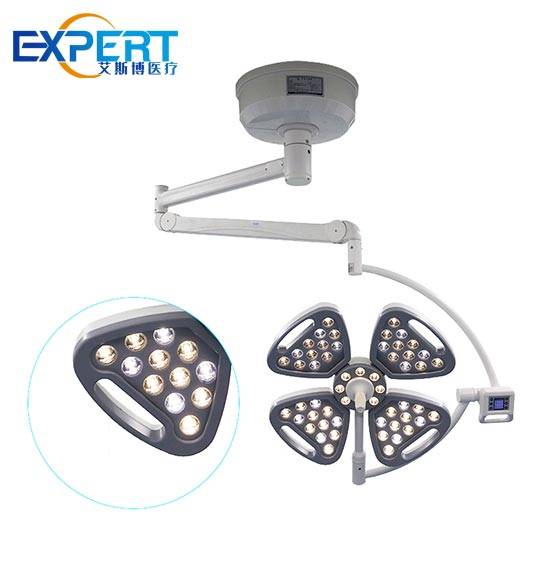Dirección
304 North Cardinal St.
Dorchester Center, MA 02124
Horas laborales
Lunes a viernes: 7:00 a. M. - 7:00 p. M.
Fin de semana: 10 a. M. - 5 p. M.
¡Bienvenido a mi blog!
Antes de profundizar en el contenido, me encantaría que te unas a mí en mis plataformas de redes sociales, donde comparto más información, interactúo con la comunidad y publico actualizaciones. Puedes conectarte conmigo de la siguiente manera:
Facebook:https://www.facebook.com/profile.php?id=100071234835011
LinkedIn:https://www.linkedin.com/company/74943205/admin/dashboard/
YouTube:www.youtube.com/@shandongexpertmedicalequip4695
TikTok:www.tiktok.com/@expertmedical
Ahora, comencemos nuestro viaje juntos. Espero que el contenido que se incluye aquí te resulte interesante, interesante y valioso.
En el ámbito de la medicina moderna, las lámparas quirúrgicas desempeñan un papel fundamental para garantizar una visibilidad y precisión óptimas durante los procedimientos quirúrgicos. Desde las tradicionales lámparas halógenas hasta los avanzados sistemas LED, la evolución de la tecnología de iluminación quirúrgica ha revolucionado el entorno del quirófano. En esta guía completa, profundizamos en los aspectos clave de las lámparas quirúrgicas, su importancia en el ámbito quirúrgico y los últimos avances que están transformando el campo.

Las lámparas quirúrgicas son sistemas de iluminación especializados, diseñados para proporcionar una iluminación brillante y sin sombras en el campo quirúrgico. Se ubican estratégicamente sobre la mesa de operaciones para iluminar el campo quirúrgico, minimizando el deslumbramiento y las sombras. A continuación, se presenta una tabla que compara diferentes tipos de lámparas quirúrgicas según sus parámetros clave:
| Tipo | Fuente de luz | Temperatura del color | Intensidad (Lux) | Esperanza de vida (horas) |
|---|---|---|---|---|
| Halógeno | Bombilla halógena | 3.500 – 4.500 mil | 30,000 – 60,000 | 1,000 – 2,000 |
| CONDUJO | Diodo emisor de luz | 4.500 – 5.500 K | 60,000 – 160,000 | 30,000 – 60,000 |
| Xenón | Bombilla de xenón | 5.000 – 6.000 K | 100,000 – 160,000 | 1,000 – 2,000 |
Las luces quirúrgicas se evalúan en función de varias características cruciales que determinan su eficacia e idoneidad para diversas aplicaciones quirúrgicas:
Las lámparas quirúrgicas son indispensables en una amplia gama de especialidades médicas, entre ellas:
Cirugía GeneralProporciona una iluminación clara y uniforme del campo quirúrgico para diversos procedimientos, como apendicectomías, reparaciones de hernias y cirugías laparoscópicas. La iluminación garantiza una visibilidad óptima durante toda la operación.
Cirugía OrtopédicaFacilita una visualización precisa y detallada durante reemplazos articulares complejos, reparaciones de fracturas y cirugías de columna. Una iluminación precisa es esencial para obtener resultados exitosos en estos procedimientos complejos.
NeurocirugíaGarantizar una iluminación óptima y enfocada para procedimientos altamente delicados que involucran el cerebro y la médula espinal, como resecciones de tumores y reparaciones de aneurismas. La precisión en la iluminación puede influir significativamente en el éxito de estas operaciones críticas.
Cirugía plástica:Mejorar la visibilidad y la precisión para procedimientos meticulosos como reconstrucciones faciales, aumentos de senos y cirugías cosméticas que requieren el máximo nivel de precisión y atención al detalle.

Elegir la técnica quirúrgica adecuada luces implica una cuidadosa consideración de varios factores:
Las lámparas quirúrgicas son herramientas indispensables en los quirófanos modernos, ya que proporcionan a los cirujanos la iluminación necesaria para realizar procedimientos complejos de forma segura y eficaz. Desde las tradicionales lámparas halógenas hasta los avanzados sistemas LED, la evolución de la tecnología de iluminación quirúrgica continúa impulsando mejoras en los resultados de los pacientes y la eficiencia quirúrgica. Al comprender las características y ventajas clave de los diferentes tipos de lámparas quirúrgicas, los centros sanitarios pueden tomar decisiones informadas para mejorar la experiencia quirúrgica tanto de los pacientes como del personal médico.
P: ¿Las lámparas quirúrgicas LED son adecuadas para todo tipo de cirugías?
R: Sí, las lámparas quirúrgicas LED son versátiles y se pueden utilizar en diversas especialidades quirúrgicas. Sin embargo, es fundamental asegurarse de que el modelo de lámpara específico cumpla con los requisitos del procedimiento que se va a realizar.
P: ¿Cómo elijo la lámpara quirúrgica adecuada para mi quirófano?
R: Al seleccionar luces quirúrgicas, tenga en cuenta factores como la intensidad de la luz, la reproducción del color, la capacidad de ajuste y la compatibilidad con el diseño y el equipo del quirófano.
P: ¿Se pueden esterilizar las lámparas quirúrgicas entre procedimientos?
R: Dependiendo del diseño, algunas lámparas quirúrgicas cuentan con mangos o cubiertas extraíbles y autoclavables que facilitan la esterilización. Es fundamental seguir las recomendaciones del fabricante para los procedimientos de limpieza y esterilización.
P: ¿Se pueden esterilizar las lámparas quirúrgicas entre procedimientos?
R: Dependiendo del diseño, algunas lámparas quirúrgicas cuentan con mangos o cubiertas extraíbles y autoclavables que facilitan la esterilización. Es fundamental seguir las recomendaciones del fabricante para los procedimientos de limpieza y esterilización.
P: ¿Cuáles son los requisitos de mantenimiento de las lámparas quirúrgicas?
R: Las tareas de mantenimiento de rutina para las luces quirúrgicas pueden incluir el reemplazo de bombillas, la limpieza de lentes y reflectores y la inspección periódica para detectar cualquier signo de daño o mal funcionamiento.
